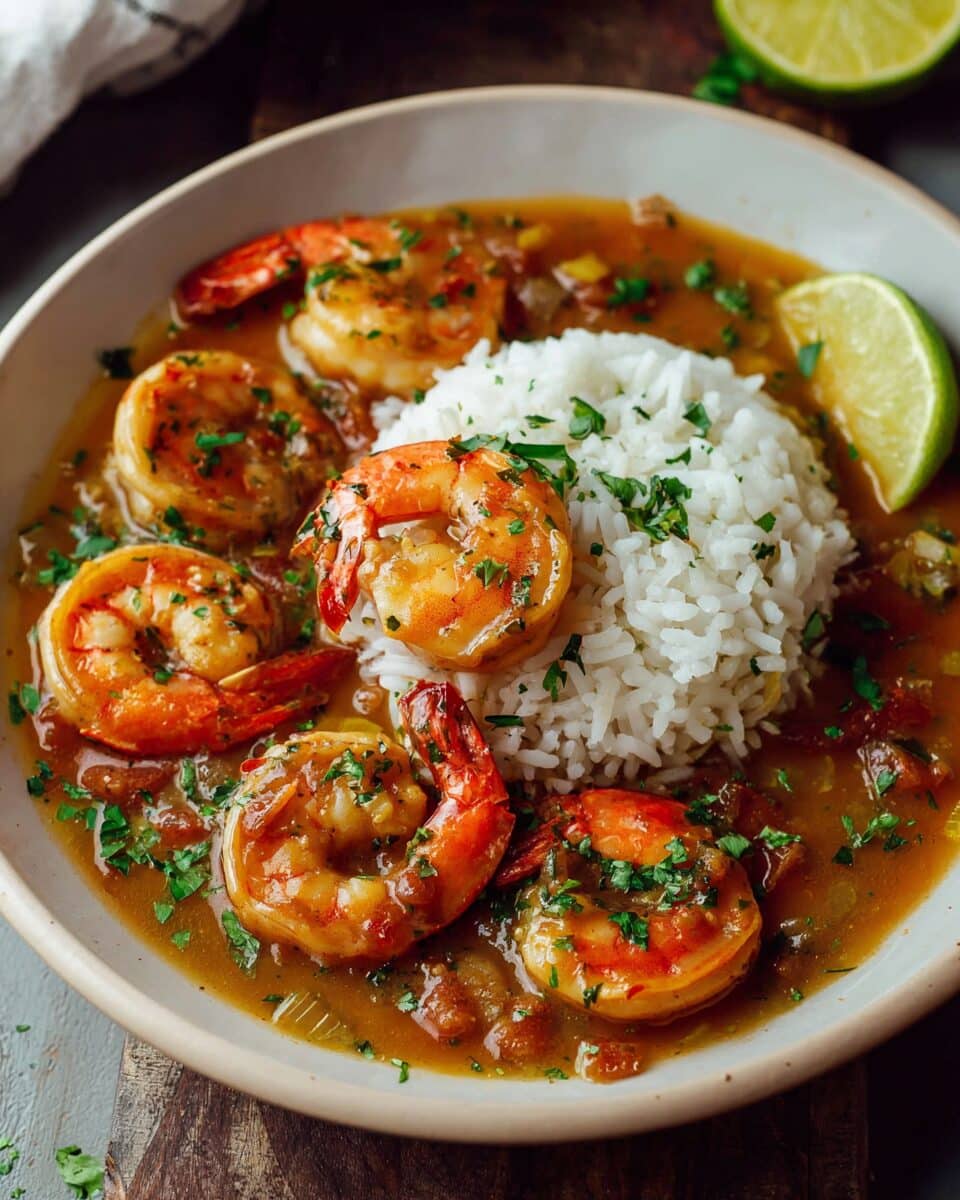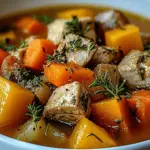The heart and soul of Louisiana cooking come alive in this classic Shrimp Étouffée. Featuring a deeply flavorful Cajun roux, the holy trinity of aromatics, and juicy shrimp, this dish is the epitome of comforting Southern cuisine. Perfect for a weeknight dinner or a special gathering, this meal is both rustic and refined.
The magic lies in the “smothering” technique, where the shrimp are gently simmered in the rich sauce just before serving to preserve their tender texture. Serve it over a fluffy bed of white rice and garnish with fresh herbs for a plate that delivers bold flavor, soul-warming comfort, and irresistible Southern charm.
Full recipe:
Ingredients:
For the Shrimp:
-
1½ lbs shrimp (peeled and deveined)
-
1 tablespoon Cajun seasoning
-
1 tablespoon olive oil
For the Roux:
-
⅔ stick unsalted butter (about 5 tablespoons + 1 teaspoon)
-
⅓ cup all-purpose flour
-
2 cups chicken broth (or shrimp stock)
Holy Trinity (Base Veggies):
-
1 medium onion, diced
-
½ cup green bell pepper, diced
-
1–2 stalks celery, chopped
Spices & Add-ins:
-
1 teaspoon thyme (dried or fresh)
-
3 teaspoons garlic, minced
-
2 bay leaves
-
1 tablespoon Worcestershire sauce
-
1 cup fresh tomato, diced
-
1 tablespoon Creole or Cajun seasoning
-
Salt and black pepper to taste
Garnishes:
-
¼ cup green onions, sliced
-
¼ cup parsley, chopped
-
Juice of ½ lemon
Directions:
-
Mix the Seasonings: In a small bowl, combine Cajun seasoning, thyme, paprika, cayenne, garlic powder, onion powder, black pepper, and white pepper.
-
Prepare the Shrimp: Pat shrimp dry, toss with a pinch of salt and half the spice mix.
-
Quick Sear: Heat olive oil in a large skillet over high heat. Add shrimp and sear for 1 minute per side, until just pink. Remove and set aside.
-
Make the Roux: In the same skillet, melt butter over medium heat. Add flour, stirring constantly for 3–4 minutes until golden brown and nutty.
-
Add Veggies: Stir in diced onions, bell pepper, and celery. Cook until softened, about 5 minutes. Add garlic and the rest of the seasoning mix. Cook another 2 minutes.
-
Tomatoes & Stock: Stir in diced tomatoes. Slowly add broth while whisking to avoid lumps. Bring to a gentle simmer and let thicken, 5–7 minutes.
-
Finish the Sauce: Stir in Worcestershire sauce, bay leaves, and hot sauce if desired. Simmer until slightly thickened.
-
Return the Shrimp: Add seared shrimp and their juices back to the skillet. Let them warm in the sauce for 2–3 minutes until just cooked through.
-
Serve: Remove bay leaves. Stir in parsley, green onions, and lemon juice. Serve hot over fluffy white rice.
Prep Time: 10 minutes | Cooking Time: 30 minutes | Total Time: 40 minutes
Kcal: 260 kcal | Servings: 4 servings
A Flavorful Dive into Classic Shrimp Etouffee
Shrimp Etouffee is more than just a meal—it’s a celebration of culture, history, and Southern culinary traditions all simmered together in a single pot. This rich, hearty, and deeply satisfying dish has earned a place at the table of many food lovers across the globe, and once you taste it, you’ll understand why.
Rooted in the heart of Louisiana, Shrimp Etouffee combines French and Creole cooking techniques with bold Cajun flavors, creating a dish that’s both rustic and refined. From its humble beginnings in small Southern kitchens to its presence in high-end New Orleans restaurants, this dish carries with it stories of family gatherings, cultural pride, and a passion for big, bold flavors.
What is Shrimp Etouffee?
The word “étouffée” (pronounced ay-too-fay) comes from the French verb étouffer, which means “to smother.” In culinary terms, it refers to a method of slow-cooking seafood or meat in a thick, flavorful sauce, often served over rice. Shrimp Etouffee typically starts with a dark roux—a mixture of flour and fat that’s cooked until deeply golden—which provides a nutty and robust flavor base. To this, we add the “Holy Trinity” of Cajun cuisine: onions, celery, and green bell peppers.
The shrimp are added at the end to retain their tender texture, and the whole mixture is seasoned with layers of garlic, Creole spices, Worcestershire sauce, and fresh herbs. The result? A deeply comforting meal with complex flavor and just the right amount of heat.
A Brief History of Etouffee
Etouffee originated in the bayous and river towns of Louisiana, where local cooks adapted French culinary traditions to the ingredients available in the region. While the dish can be made with crawfish, crab, or chicken, shrimp became a popular option due to its wide availability and affordability.
Over time, Shrimp Etouffee became a staple in both Cajun and Creole households. The distinction between Cajun and Creole versions lies mainly in the ingredients and techniques. Creole versions often use tomatoes and butter, reflecting the influence of French and Spanish settlers, while Cajun versions lean more heavily on spices and oil-based roux.
Regardless of the variation, Etouffee is revered for its bold, comforting flavors and its ability to feed a crowd. It’s the kind of dish that feels like a warm hug from the South—rich, soulful, and absolutely unforgettable.
Why This Shrimp Etouffee Recipe Stands Out
What sets this particular Shrimp Etouffee recipe apart is its perfect balance between authenticity and accessibility. It respects traditional cooking methods—like building a proper roux and layering spices—while offering a streamlined process that even home cooks can follow with ease.
Here’s why this version is truly special:
-
Quick and Weeknight-Friendly: Despite its depth of flavor, this recipe comes together in just 40 minutes, making it ideal for busy weeknights.
-
Restaurant-Quality Flavor at Home: The rich roux and aromatic base deliver the kind of depth you’d expect from a professional kitchen.
-
Flexible Ingredients: You can easily swap shrimp for other proteins, such as crawfish, crab, or even mushrooms for a vegetarian version.
-
Budget-Conscious: With pantry staples like flour, onion, and broth, this recipe is surprisingly affordable without compromising taste.
Ingredient Highlights and Their Roles
Each ingredient in this recipe has a specific role, contributing to the balance of flavor, texture, and aroma. Let’s take a closer look:
-
Shrimp: The star of the show. Choose wild-caught or fresh Gulf shrimp if possible. Their natural sweetness contrasts beautifully with the bold sauce.
-
Roux (Butter + Flour): The roux is essential. It acts as both a flavor base and a thickener, giving the sauce its signature silky texture.
-
The Holy Trinity (Onion, Bell Pepper, Celery): This trio forms the aromatic backbone of Cajun and Creole dishes. Cooked down slowly, they add body and savory sweetness to the sauce.
-
Tomatoes: Used in Creole-style Etouffee, tomatoes provide acidity that cuts through the richness of the roux.
-
Worcestershire Sauce: Adds umami depth and a subtle tang that elevates the entire dish.
-
Creole or Cajun Seasoning: The heart of the flavor. It brings heat, smokiness, and character to the sauce.
-
Fresh Herbs (Parsley and Green Onion): These brighten the final dish and provide a fresh, herby lift.
-
Lemon Juice: A splash of acidity right before serving helps balance the richness and enhances the shrimp’s flavor.
Health Benefits of Shrimp Etouffee
While Shrimp Etouffee is often considered indulgent, it offers several health benefits when made with care:
-
High in Protein: Shrimp is a lean source of protein and provides essential nutrients like selenium, iodine, and vitamin B12.
-
Low in Carbohydrates: Served with a moderate amount of rice, this dish remains relatively low in carbs compared to many other comfort foods.
-
Homemade = Healthier: By making your own roux and seasoning, you control the sodium and fat content. Use olive oil instead of butter and low-sodium broth for an even lighter version.
-
Packed with Vegetables: The Holy Trinity not only adds flavor but also contributes essential vitamins and fiber.
Of course, moderation is key—especially if you’re watching fat intake—but this is one dish where flavor and health can coexist beautifully.
Pairing Suggestions: What to Serve with Shrimp Etouffee
Shrimp Etouffee is typically served over fluffy white rice, but there are plenty of complementary sides that can turn it into a full Southern spread.
-
Cornbread: Adds a slightly sweet, crumbly texture that pairs well with the saucy shrimp.
-
Collard Greens or Mustard Greens: Bitter greens contrast nicely with the richness of the dish.
-
Fried Okra: Adds a crunchy, satisfying element.
-
Steamed Asparagus or Green Beans: Lighter veggies balance the meal and add freshness.
-
Garlic Bread: For those who want to mop up every drop of that glorious sauce.
Pair with a crisp white wine like Sauvignon Blanc or a light beer to round out the meal.
Common Mistakes and Tips for Success
Like any recipe with a strong culinary tradition, there are a few tricks to getting it just right:
-
Don’t Rush the Roux: The roux is the heart of the dish. Take your time, stir constantly, and wait for that deep, golden-brown color.
-
Add Shrimp at the End: Shrimp cook fast! Adding them too early results in a rubbery texture.
-
Taste as You Go: Season gradually. Cajun seasoning blends vary in saltiness and heat, so adjust to your liking.
-
Make it Ahead: The sauce gets better with time. Make the base a day ahead and add the shrimp right before serving.
Cultural Significance of Etouffee in Louisiana
Etouffee is more than a meal—it’s a cultural symbol. It tells the story of resilience, adaptation, and creativity among the Cajun and Creole people of Louisiana. These communities made the most of what they had—simple ingredients, local seafood, and bold seasonings—to create dishes that are now beloved worldwide.
In many Louisiana homes, Etouffee is not just food; it’s an event. It’s served during holidays, Sunday dinners, and community gatherings. It’s part of a shared identity, passed down through generations.
This connection to tradition is part of what makes cooking and eating Shrimp Etouffee such a soulful experience. You’re not just preparing a meal—you’re preserving a legacy.
Conclusion
Shrimp Etouffee is a dish that manages to be both comforting and impressive, traditional and flexible, hearty and wholesome. Its roots run deep in Southern culture, and its bold, savory flavor leaves a lasting impression on everyone who tastes it. Whether you’re new to Cajun cuisine or a lifelong fan, this recipe is a must-try.
With a rich roux, tender shrimp, and just the right amount of spice, it’s no wonder Shrimp Etouffee is considered one of the crown jewels of Louisiana cooking. Make it once, and you’ll be craving it again and again—because some meals just speak to the soul.






